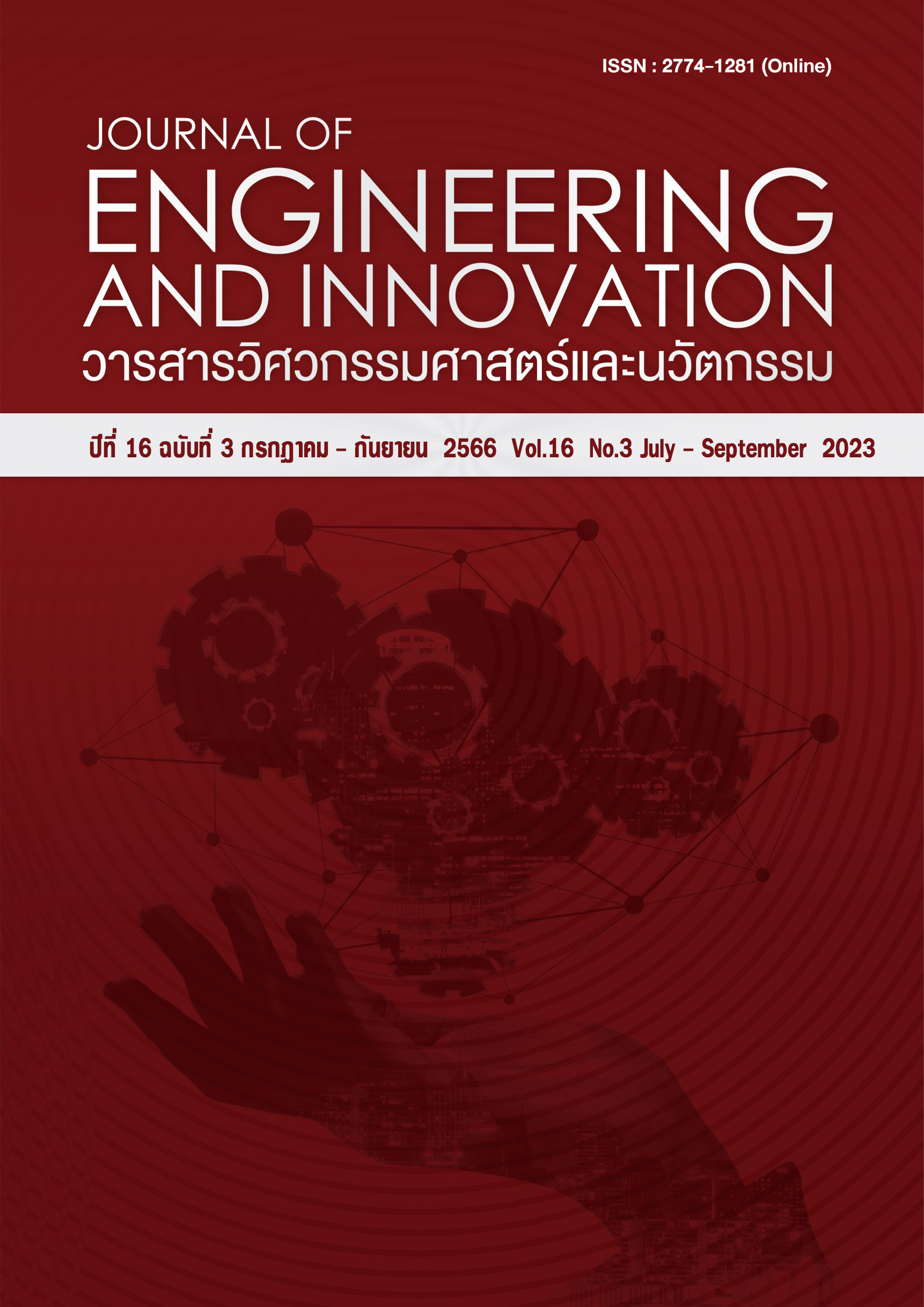The reduction of Impact loading damage of rectangular concrete-filled steel tubular beams
Main Article Content
Abstract
The structural design against impact loading is generally used impact factor to increase capacity of structural member, which may not be very accurate. This is because the impact force, reaction force, and especially inertia force are occurred in structural member under impact load, which are not considered in static problem. In this research, the impact behavior of 9 simple beams, including reinforced concrete beams (RC) and rectangular concrete-filled steel tube beams (CFST) designed to have same load capacities and hollow steel beams (HS), under dropped steel hammer 160 kg from 700 mm height were observed. The results revealed that the most of impact force in early stage was absorbed by inertia force. The CFST beams which have elastic stiffness less than RC beams significantly showed the well impact loading performance. They can reduce the impact forced more than 7 times compared to RC beams with same load capacities and also reduced the reaction force from colliding events. The RC beams reached the brittle failure and HS beams occurred the local buckling at the impact point. Nevertheless, CFST beams did not demonstrate any damage. These results illustrate that CFST beams are appropriate to resist impact load.
Article Details
References
BSI U. National annex to eurocode 1: Actions on structures–part 2: Traffic loads on bridges, NA to BS EN 1991-2: 2003: British Standards Institution; 2008.
AASHTO.Bridge design specifications. Washington DC: American association of state highway transportation officials; 2012.
CEB. Concrete structures under impact and impulsive loading. Lausanne: Bulletin information; 1988.
Micallef K, Sagaseta J, Ruiz MF, Muttoni A. Assessing punching shear failure in reinforced concrete flat slabs subjected to localised impact loading. International Journal of Impact Engineering. 2014;71:17-33.
Pham TM, Hao H. Behavior of fiber-reinforced polymer-strengthened reinforced concrete beams under static and impact loads. International Journal of Protective Structures. 2017;8(1):3-24.
Qin F, Pingan W. Main factors affecting failure modes of blast loaded RC beams. Chinese Journal of Computational Mechanics. 2003;20(1):39-42.
Han LH, Li W, Bjorhovde R. Developments and advanced applications of concrete-filled steel tubular (CFST) structures: Members. Journal of Constructional Steel Research. 2014;100:211-228.
Han L-H, Yao G-H, Tao Z. Performance of concrete-filled thin-walled steel tubes under pure torsion. Thin-Walled Structures. 2007;45(1):24-36.
Ekmekyapar T, Alwan OH, Hasan HG, Shehab BA, Al-Eliwi BJ. Comparison of classical, double skin and double section CFST stub columns: Experiments and design formulations. Journal of Constructional Steel Research. 2019;155:192-204.
Espinos A, Romero ML, Lam D. Fire performance of innovative steel-concrete composite columns using high strength steels. Thin-Walled Structures. 2016;106:113-128.
Wang Y-H, Wang Y-Y, Hou C, Zhou X-H, Deng R, Lan Y-S, et al. Combined compression-bending-torsion behaviour of CFST columns confined by CFRP for marine structures. Composite Structures. 2020;242:112-131.
Zhu M, Liu J, Wang Q, Feng X. Experimental research on square steel tubular columns filled with steel-reinforced self-consolidating high-strength concrete under axial load. Engineering Structures. 2010;32(8):2278-2286.
Cai J, Pan J, Wu Y. Mechanical behavior of steel-reinforced concrete-filled steel tubular (SRCFST) columns under uniaxial compressive loading. Thin-Walled Structures. 2015;97:1-10.
Yousuf M, Uy B, Tao Z, Remennikov A, Liew JR. Transverse impact resistance of hollow and concrete filled stainless steel columns. Journal of Constructional Steel Research. 2013;82:177-189.
Yousuf M, Uy B, Tao Z, Remennikov A, Liew JR. Impact behaviour of pre-compressed hollow and concrete filled mild and stainless steel columns. Journal of Constructional Steel Research. 2014;96:54-68.
Al-Rifaie A, Jones S, Wang Q, Guan Z. Experimental and numerical study on lateral impact response of concrete filled steel tube columns with end plate connections. International Journal of Impact Engineering. 2018;121:20-34.
ACI Committee. Building code requirements for structural concrete (ACI 318-08) and commentary. Farmington Hills: ACI; 2008.
ANSI/AISC 360-16. Specification for Structural Steel Buildings. Chicago: AISC; 2016.
Lai Z, Varma AH, Zhang K. Noncompact and slender rectangular CFT members: Experimental database, analysis, and design. Journal of Constructional Steel Research. 2014;101:455-468.
Pham TM, Hao H. Impact behavior of FRP-strengthened RC beams without stirrups. Journal of Composites for Construction. 2016;20(4):11-24.
Saatci S, Vecchio FJ. Effects of shear mechanisms on impact behavior of reinforced concrete beams. ACI structural Journal. 2009;106(1):78-86.
ปิยะพงษ์ วงค์เมธา, ชยานนท์ หรรษภิญโญ. การวิเคราะห์การรับแรงกระแทกของคานคอนกรีตเสริมเหล็กที่มีอัตราส่วนของระยะช่วงเฉือนต่อความลึกต่างกัน. วารสารวิศวกรรมศาสตร์ มหาวิทยาลัยเชียงใหม่. 2018;25(3):211-223.

